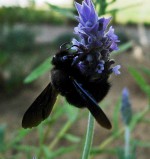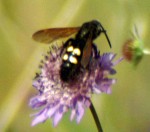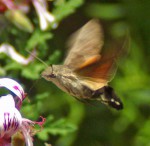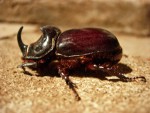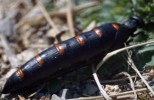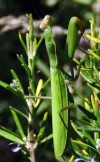The Sierra de la Nieves, or ‘Mountains of the Snows’, forms part of the Serrania de Ronda and rises dramatically above the surrounding valleys and countryside. The Natural Park covers an area of 30km by 20km, or 18,530 hectares; the peak is the tip of the ‘Torecilla’ at 1,919 metres. Historically, this was a place of refuge for highwaymen and outlaws, but today the Sierra de las Nieves is considered one of the best places in Europe for the study of nature. The area was studied in the 19th century by Swiss botanist Edmond Boissier and in 1933 by Luis Ceballos; in 1970 the park was declared a National Hunting Reserve and then in 1995 a Biosphere Reserve by UNESCO.
Access : Take the Ronda road from San Pedro, the A376, which must be one of the most scenic routes in southern Spain. The road twists and turns upwards into the mountains, each bend revealing spectacular views across to the North African coast on one side and craggy wooded mountains on the other.
Roadside signs in amusing graphics warn motorists that this is a favourite route for motorcyclists, particularly at the weekends, who often travel at speed and in groups, meeting up at various ventas. Although they do get close behind you before overtaking, in the main they are just eager to practise their driving skills and impress their girlfriends and are not being aggressive!
Eventually the road levels out and you are in the ‘moonscape’ of bare silver-white limestone crags. The entrance to the park is on your right-hand side, turning in at km136 It is quite well marked, but if you do miss it, carry on a short way and you will see a couple of ventas on your left where you can pull in and turn around. We always stop here for coffee and toast (and the toilet facilities) before setting off for a day in the park.
There is a surfaced road that extends about 10km inwards. The first few kilometres of the road are currently not in the best of condition, and a 4×4 vehicle is an asset, although more ‘normal’ cars manage OK: the road surface improves dramatically after a while and we had a comfortable journey to the ‘area recreativo’, where we parked.
Around mid-June the latter end of the road is closed off, probably as a precaution against fire and the only way to reach the area recreativo (where there are also toilets), and to access the centre of the park is on foot. It is actually a good route to walk with a profusion of flowering plants attracting a host of butterflies that you miss when driving. You are able to hear any birds that may be singing too, we have heard and seen both Olivaceous and Melodious Warblers from here when walking and had some really good views of Crossbills feeding on pine cones too.
The park is home to the Pinsapo pine, an ancient species found in only three locations in Andalucia, this being one of them and there are deciduous oaks,or Quegijales too.


